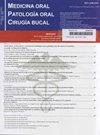Antibiotic prescribing patterns in the placement of dental implants in Europe: A systematic review of survey-based studies.
IF 2.1
3区 医学
引用次数: 0
Abstract
BACKGROUND The present systematic review aims to investigate the guidelines for prescribing Preventive Antibiotic Therapy (PAT) in the placement of dental implants (DIs) without anatomical constraints in healthy patients by clinicians in Europe and to compare them with current recommendations. MATERIAL AND METHODS A search was performed in 4 databases: Medline (via PubMed), Web of Science, Scopus, and LILACS. The criteria employed were those described in the PRISMA (Preferred Reporting Items for Systematic Reviews and Meta-Analysis) declaration (PROSPERO Registration number: CRD42022382278). RESULTS The electronic search identified 10 studies published between 2010 and 2023 that met the established criteria. Overall, 60.8% ± 24.1% of European professionals routinely prescribe PAT, with the most frequent regimen being perioperative (mean= 46.7% ± 24.3%), followed by postoperative PAT only (mean= 20.3% ± 9.7%). CONCLUSIONS The most commonly prescribed antibiotic both pre- and postoperatively is amoxicillin and, in allergic patients, clindamycin. In Europe, more doses of PAT are being prescribed than suggested by current recommendations. For this reason, more PAT education is needed in educational curricula to promote a more rational use of antibiotics to reduce the occurrence of antimicrobial resistance.欧洲牙科植入物植入过程中的抗生素处方模式:基于调查研究的系统性综述。
背景本系统综述旨在研究欧洲临床医生在无解剖限制的情况下为健康患者植入牙科种植体(DI)时开具预防性抗生素疗法(PAT)处方的指南,并将其与当前的建议进行比较:Medline(通过 PubMed)、Web of Science、Scopus 和 LILACS。采用的标准是 PRISMA(系统综述和元分析的首选报告项目)声明中所述的标准(PROSPERO 注册号:CRD42022382278)。结果电子检索确定了 2010 年至 2023 年间发表的 10 项符合既定标准的研究。总体而言,60.8%±24.1% 的欧洲专业人员会常规处方 PAT,最常用的方案是围手术期(平均值= 46.7% ± 24.3%),其次是仅在术后处方 PAT(平均值= 20.3% ± 9.7%).结论术前和术后最常用的处方抗生素是阿莫西林,过敏患者则使用克林霉素。在欧洲,PAT 的处方剂量超过了当前建议的剂量。因此,需要在教学课程中开展更多的 PAT 教育,以促进更合理地使用抗生素,减少抗菌药耐药性的发生。
本文章由计算机程序翻译,如有差异,请以英文原文为准。
求助全文
约1分钟内获得全文
求助全文
来源期刊

Medicina oral, patologia oral y cirugia bucal
Medicine-Surgery
CiteScore
4.50
自引率
0.00%
发文量
52
期刊介绍:
1. Oral Medicine and Pathology:
Clinicopathological as well as medical or surgical management aspects of
diseases affecting oral mucosa, salivary glands, maxillary bones, as well as
orofacial neurological disorders, and systemic conditions with an impact on
the oral cavity.
2. Oral Surgery:
Surgical management aspects of diseases affecting oral mucosa, salivary glands,
maxillary bones, teeth, implants, oral surgical procedures. Surgical management
of diseases affecting head and neck areas.
3. Medically compromised patients in Dentistry:
Articles discussing medical problems in Odontology will also be included, with
a special focus on the clinico-odontological management of medically compromised patients, and considerations regarding high-risk or disabled patients.
4. Implantology
5. Periodontology
 求助内容:
求助内容: 应助结果提醒方式:
应助结果提醒方式:


